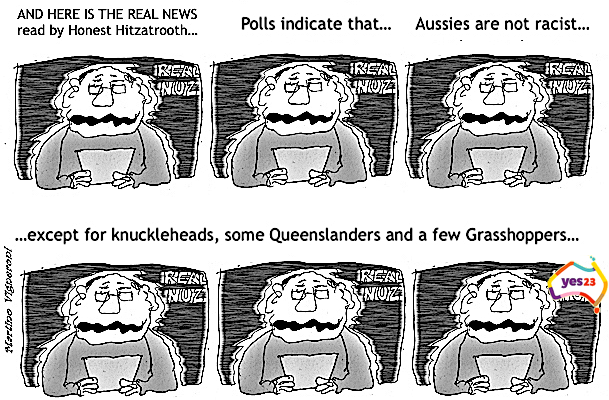Search
Democracy Links
Member's Off-site Blogs
a YES vote is de rigueur.....

In 1996 I was fortunate enough to be involved in the Centenary of the 1895 Bathurst Peoples Constitutional Convention.
The 1896 event was a grassroots gathering unlike the more official conventions of the 1890s. The colonies had not yet federated and become states of a Commonwealth of Australia, and the document which eventually emerged in 1900-1 was essentially a federal compact.
If you are proud of the Constitution, vote ‘Yes’ By Tony Smith
That is, its primary purpose was to bind the states and set out their relationship with the Australian government in Canberra. It is hardly surprising then that the Constitution seems to have a number of glaring omissions. There is no single statement of political, let alone human rights. Fortunately, executive government is balanced by a strong judicial system.
Nor is there much specifically about the institutions of government and politics. John Bannon and I facilitated a session on Parliament, and there was more comment about what the document does not say than about what it does say. It was always assumed that the federal parliament would operate as the colonies had done, and would follow the British ‘Westminster’ model. Observers then and now understand that we inherited an unwritten set of rules that are set out in conventions.
Generally this system works but it depends very much on political players adhering to these unwritten rules or understandings. The ousting of the Whitlam Government in 1975 is correctly referred to as a constitutional crisis because the system broke down as some key players wilfully ignored conventions.
The delegates of 1996 showed that they are keenly interested in their Constitution. It is after all, the ultimate constraint on governments. The Constitution begins ‘Whereas the people’. There was warm applause when the plenary session endorsed a resolution that the government should explore models of a possible republic, including a referendum.
Whether people voted in that referendum with their heads or their hearts is not clear. A later prime minister, Malcolm Turnbull commented that the monarchists of the day manipulated the process to get a negative result, thus breaking the nation’s heart.
Australians have the opportunity to show their love of the Constitution when asked whether the document should include mention of an Indigenous ‘Voice’. It is significant that the concept of the Voice arose from the Uluru Statement from the Heart, which mentioned Treaty, Truth and Voice.
The notion of the Heart refers both to the heart of Australia – Uluru – and to the way in which the people researching the needs of Indigenous peoples delivered their message. This is a statement of sincerity and of a yearning for justice.
A very negative ‘no’ campaign began with the vandalising of ‘Yes’ posters and it has continued in that same destructive way. The ‘no’ campaign has been very divisive while making absurd accusations against the ‘yes’ campaign. Its main hope seems to be that it can make people fear the idea of the Voice. It is all a bit unfortunate considering the words of John Farnham’s song ‘You’re the Voice’ about refusing to live in fear.
Most referenda are lost, partly because of the stringent rules for constitutional alteration. They should not be lost because people have been intimidated. Anyone who is confused or hesitant about what the referendum on the Voice proposes might find the AAP Fact Check and the RMIT Fact Lab helpful. Other sites which identify misleading information include the Australian Electoral Commission website and The Guardian’s critical annotated and fact checked assessment of the ‘Yes’ and ‘No’ pamphlets.
The 1896 Bathurst Convention was credited with invigorating the move to federation which had stalled somewhat. The 1996 Centenary helped the move towards a referendum about our Head of State. Bathurst people have a strong tradition of encouraging ownership of the Constitution.
Alan Moir penned a significant cartoon in the Sydney Morning Herald of 4 March 1997. It depicts the scene in 1897 with two Indigenous people sitting outside a public building which has a sign ‘People’s Convention’ being entered by top-hatted white men. The older Indigenous person says: ‘In 100 years we’ll be there … accepted, proud, healthy … humiliations long gone ….’ How long must we wait?
I will vote ‘yes’ and do it proudly. The Constitution should be a living document and not a moribund thing stuck in 1901 mode. While the document is not easy to alter, it does contain provision for alteration, so it was envisaged that it could be updated. The fact is that constitutional government is a constrained system. People should not fear any alteration which does not weaken these constraints. Adding another Voice to which government must answer increases the constitutional safeguards.
Surely, anyone of good will must welcome any change which could address the terrible gap in social outcomes between Indigenous Australians and the rest of us. I will vote ‘yes’ very much for my grandchildren. Constitutional recognition of the land’s sovereign first peoples will create a more just and open society. Surely, this is what a Constitution should do.
https://johnmenadue.com/if-you-are-proud-of-the-constitution-vote-yes/
- By Gus Leonisky at 29 Sep 2023 - 6:00am
- Gus Leonisky's blog
- Login or register to post comments
Recent comments
8 hours 39 min ago
10 hours 10 min ago
13 hours 38 min ago
17 hours 1 min ago
17 hours 22 min ago
17 hours 29 min ago
20 hours 55 sec ago
20 hours 45 min ago
21 hours 16 min ago
23 hours 18 min ago